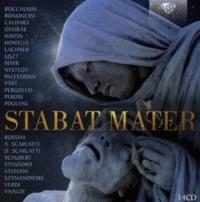
STABAT MATER
-
Autor: V/A
- EAN: 5028421953700
- Oprawa: Pudełko CD
- Wydawca: Brilliant Classics
- Format: 13.1x13.5
- Język: angielski
- Rok wydania: 2017
- Wysyłamy w ciągu: niedostępny
-
Brak ocen
-
128,68złCena detaliczna: 149,99 złNajniższa cena z ostatnich 30 dni: 128,68 zł
Artykuł chwilowo niedostępny
x
The Stabat Mater depicts Mary standing at the cross of Jesus, weeping at the sight of her son's crucifixion. The poem asks us to share in Mary's pain ('Fac, ut ardeat cor meum') and rejoice in Christ's sacrifice for mankind. The timeless bond between a mother and her son transcends the shifting world around us. Mary's anguish crosses all boundaries, speaking to anyone who has seen a loved one suffering, humanising Christ for experiencing mortal pain even while lauding him as the saviour. Not only is the theme heartfelt and tender, but the Latin text is rhythmic and lyrical, lending itself perfectly to music.
The existing versions represent a wonderful diversity of styles. In Palestrina's time, it was important that the music did not interfere with the clarity of the words. His Stabat Mater for eight voices, therefore, is simple, resonant, and wonderfully moving. Vivaldi, Caldara and both Alessandro and Domenico Scarlatti were among the Baroque composers to try their hand next; Vivaldi only set the first ten stanzas, ending with the plea to experience Mary's suffering for ourselves. The music, melancholy and minor, contrasts with Caldara's setting, which includes two trombones.
Later composers include Luigi Boccherini, who wrote some florid lines for solo soprano, the only early setting to include a soloist. By the time Haydn came to write his own Stabat Mater in 1767 he would have been familiar with those of Pergolesi and Alessandro Scarlatti. It became Haydn's most performed work in his lifetime, notable for its swapping out of the oboes for two cors anglais in two of the movements, creating a graver and more melancholy sound.
Dvořák and Liszt both created highly personal settings of the poem: Liszt because of his
strong religious impulse – he wrote the Stabat Mater as part of his oratorio Christus while
living in the Vatican, having entered the lower orders – and Dvořák because of a string of personal tragedies. The Czech composer lost his eldest daughter Josefa in 1876, which prompted him to begin sketching the music, and he returned to the composition in 1877 after the deaths of his two surviving children in close succession.

